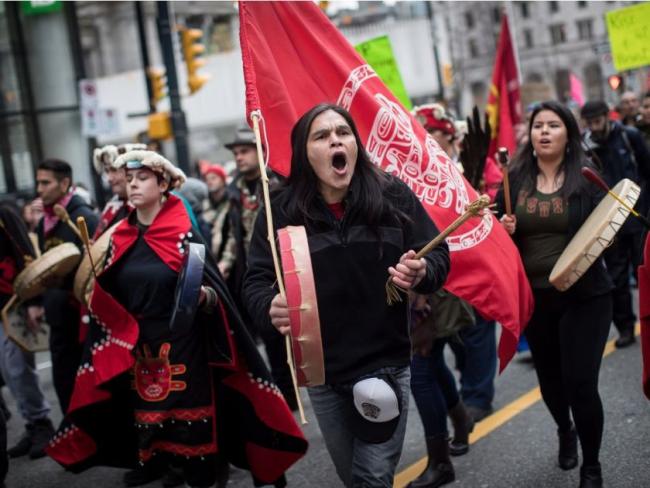Articles Menu

January 9, 2019
Anticipating the Mounties moving against the Unist’ot’en crew, another group of Wet’suwet’en chiefs set up another roadbock 20 kilometres closer to town on the Morice Forest Service Road, and, armed with an amended injunction order, the RCMP went after that group on Monday, arresting 14 people. “We respect the rights of individuals to peacefully express their point of view, as long as their activities do not disrupt or jeopardize the safety of the public, our employees, our contractors, and even themselves,” Coastal GasLink president Rick Gateman explained Monday. This was a strange echo of a statement from Public Safety Minister Ralph Goodale’s office: “The RCMP respects and protects the right to peaceful demonstrations as guaranteed under the Canadian Charter of Rights and Freedoms.”
The problem here is that the Wet’suwet’en hereditary chiefs were not intending to merely “express their views,” peacefully or otherwise, and the Charter of Rights has nothing to do with it. The Charter comes under Section 25 of the Constitution. Aboriginal rights are protected in Section 35. It’s the aboriginal rights and title of the Wet’suewet’en people that are at stake here, and that’s the subject that the federal Liberal government, and B.C.’s NDP government, are trying to avoid.
The thing is, it doesn’t much matter what those 20 band councils have to say for themselves. What matters is what the Wet’suwet’en hereditary chiefs and their clans and their house groups say, and for several years they have been saying, fairly consistently, thanks, but no thanks, no pipeline, no damn way.
The band councils will do what they think they need to do, so fair play to them. But they’re like municipal governments. In Wet’suwet’en country, the law is the ancient feast system, and the hereditary chiefs are bound to uphold the law. That’s not just some hippie anthropologist’s point of view, either. It’s the view of the Supreme Court of Canada, in its specific findings in the landmark 1997 Gitxsan and Wet’suwet’en case, Delgamuukw versus the Queen. It was the hereditary chiefs who fought and won that court battle. In Wet’suwet’en country, aboriginal rights and title are vested in the hereditary chiefs and their clans and their house groups.

A sign for a blockade check point by the Gidimt’en clan of the Wet’suwet’en First Nation is shown in this undated handout photo posted on the Wet’suwet’en Access Point on Gidumt’en Territory Facebook page.HO / THE CANADIAN PRESS
Whatever the region’s band councils have to say, the Coastal Gaslink pipeline route enters Wet’suwet’en territory at a place called Honeagh Bin, which is under the authority of the Thin House (Yexsowwiten) chief, whose people are members of the Big Frog (Gilseyhyu) clan. The pipeline route then traverses Small Frog (Laksilyu) property held by the House of Many Eyes (Ginehklaiyex), and on and on like this until it passes through the house territories of the Bear/Wolf clan (Gitumd’in), one of whose chiefs, Madeek (Jeff Brown) was a leader at the roadblock the RCMP dismantled on Monday. Eventually, the pipeline route reaches Talbiits Kwa, another Big Frog territory, which is where the Unist’ot’en have been controlling traffic on the forest service road for the last several years. The route then leaves Wet’suwet’en country at Lho Kwah, and enters the Haisla Nation territory. The Haisla are organized mainly into the Kitamaat First Nation, which generally supports the LNG Canada project.
If you think that’s a jurisdictional nightmare, bear in mind that the National Energy Board still doesn’t even know whether it’s involved in any of this, or whether provincial or federal jurisdiction holds higher sway. The NEB will be holding hearings in March to determine whether the British Columbia Oil and Gas Commission gave the whole project the go-ahead unlawfully. If that’s how things shake out, the whole project has to be re-submitted for approval under a formal, dismal, drawn-out NEB process.
The other thing both the federal and provincial governments are trying to avoid is any public scrutiny of Trudeau’s and Premier John Horgan’s eloquent (but oddly imprecise) commitments to First Nations that their consent should be required, as per the United Nations’ guidance, for industrial developments such as pipelines to proceed in areas subject to some degree of aboriginal title.
So go ahead and blame those obstreperous Wet’suwet’en people all you like but it’s avoiding these tougher questions that caused this whole thing to go so wrong in the first place. And that’s without even dealing with whether there is any right way, if Canada is going to come even close to meeting its Paris Accord commitments, to do these sorts of projects at all.
Terry Glavin is an author and journalist.
[Top photo: Alex Spence, centre, who is originally from Haida Gwaii, beats a drum and sings during a march in support of pipeline protesters in northwestern British Columbia, in Vancouver, on Tuesday. DARRYL DYCK / THE CANADIAN PRESS]